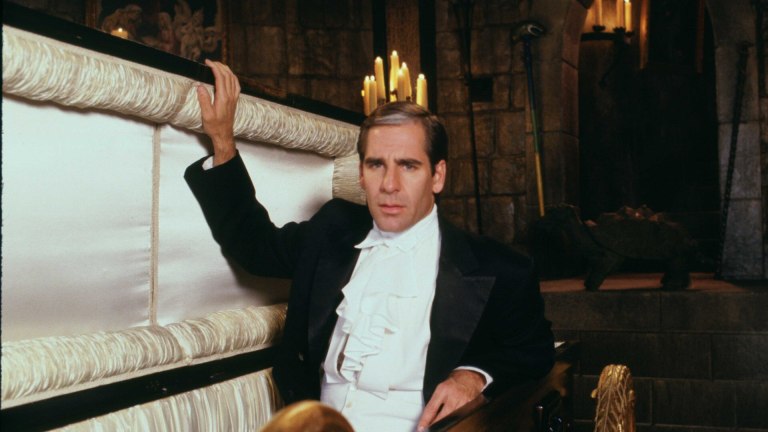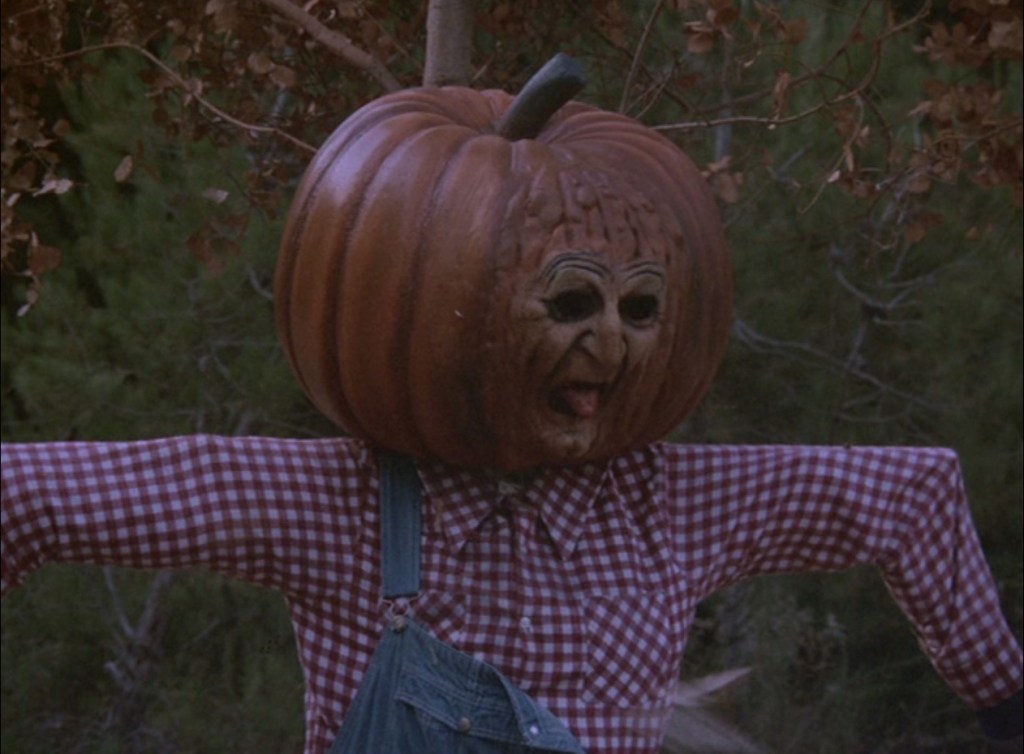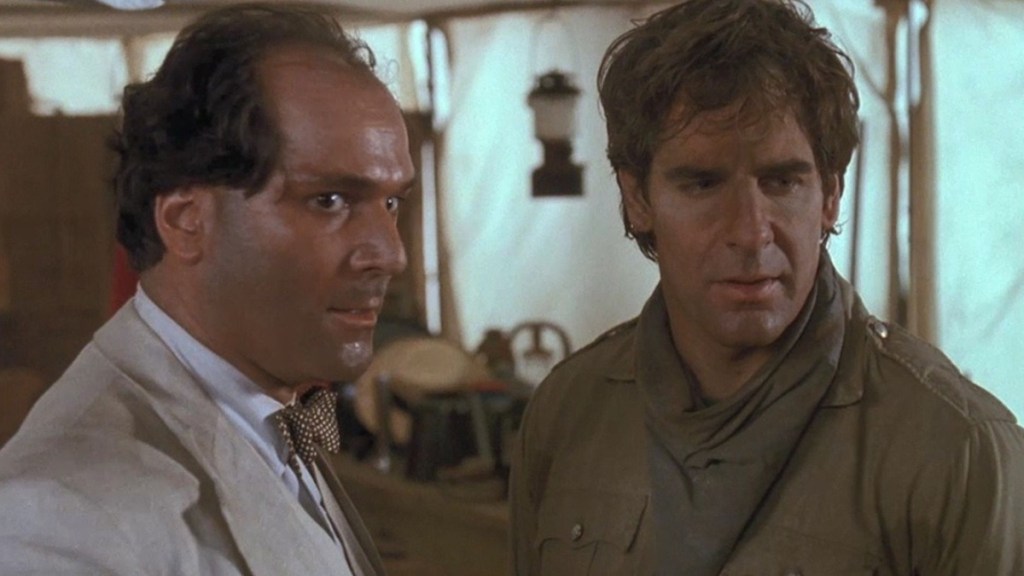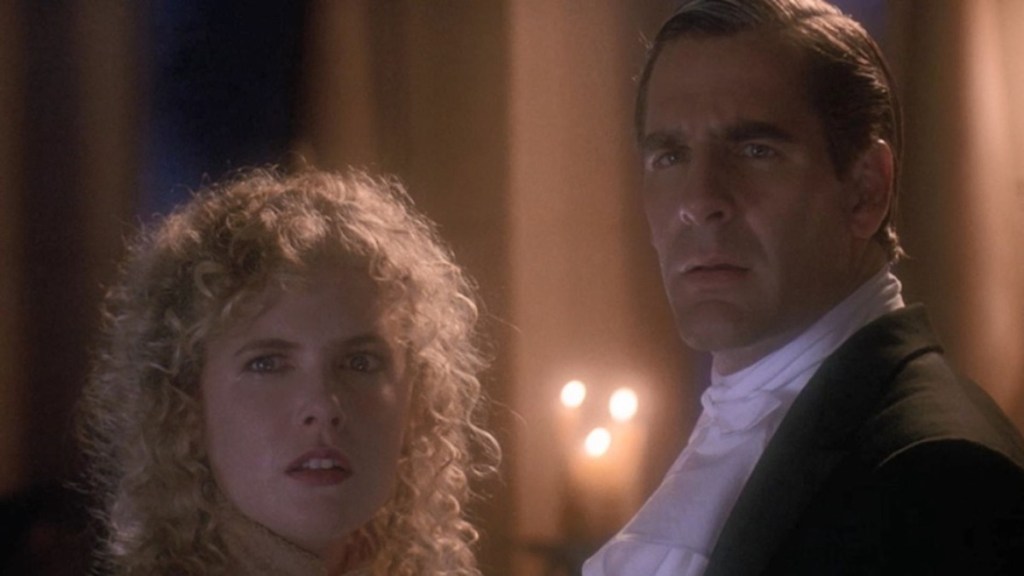Quantum Leap at Halloween: Revisiting Sam and Al’s Leaps To The Dark Side
‘90s TV favorite Quantum Leap didn’t spend much time on the supernatural but when it did… oh boy.

Ghosts, vampires, mummies and the Devil are not things you would necessarily associate with a show like Quantum Leap.
Yet the premise behind creator Donald P. Bellisario’s cult favorite was one that required Scott Bakula’s body-snatching protagonist, Dr. Sam Beckett, to wear many hats – and, in one instance, a set of fangs.
Having leapt through spacetime during an experiment gone awry, Sam spent the show’s 97-episode run inhabiting a wild array of characters, always with the aim of “putting right what once went wrong” and aided by Dean Stockwell’s Al, a hologram only Sam can see.
It was a setup that allowed Bellisario and the show’s writers to get creative and, every now and then, spring a supernatural surprise.
“The great thing about Quantum Leap was that every episode could be vastly different,” writer and producer Chris Ruppenthal told Den of Geek.
“You weren’t just writing a hospital show or a cop show. It also had this rare blend where you could have humor, action, romance, social commentary and even the supernatural. That’s what made every episode feel fresh – you didn’t quite know what was going to happen.”
Fellow writer and producer Scott Shepherd agreed. “The show could go from being about a baseball player to an astronaut to a cabaret singer to a ghost hunter. It could go to any genre and tell a story,” he said.
However, while the format offered plenty of freedom, Shepherd stressed every episode required one key ingredient. “When I first saw the show, I initially thought it was like Back to the Future, where he’s jumping into all these weird, fun situations. But it wasn’t about that at all,” he said. “It had this heart and Don Bellisario would always talk about ‘the heart of the show’ and what Sam was about.”
Shepherd recalled an early test screening of the show’s two-hour opening episode, “Genesis.” Sam finds himself transported into the body of a baseball player in the 1950s and realizes, at that precise point in time, his father is still alive. So goes to a payphone and calls him.
“When they tested that episode with the audience, the ratings were off the charts during that particular scene,” Shepherd said. “That was when I understood what the show was about.”
As long as the heart was there and Sam imparted what Shepherd called the moral “life lessons” of the episode they could take things in any direction – and, oh boy, didn’t they just.

A Portrait for Troian
Quantum Leap’s first foray into the world of the supernatural came midway through the show’s second season with the ghostly “A Portrait for Troian,” co-written by Shepherd.
It saw Sam leap into the body of Dr. Timothy Mintz (Bellisario played the real Mintz’s reflection), a parapsychologist employed by wealthy heiress Troian Claridge to investigate whether her deceased husband Julian is contacting her from beyond the grave. Al soon reveals, however, that Sam is there to stop Troian from drowning in the same lake where Julian died.
There are two suspects: Troian’s brother, Jimmy, who stands to inherit the estate, or the housekeeper Ms Stoltz, who occupies a strange role in the house and appears to be able to see Al. As the episode progresses, Troian finds herself haunted by the presence of wet footprints by her bed and the reappearance painting she previously threw into the lake.
While Sam is skeptical of any supernatural involvement, Al is cast as believer in the spirit world, creating an interesting dynamic explored throughout the show’s run and fleshed out further in other network shows. “There was this unique bromance to their relationship,” Shepherd said. “So having Al believe in ghosts gave things another dimension. I always found it interesting that dynamic predated The X-Files.”
Ultimately, Jimmy would be revealed as the culprit, but there would be a further twist in the tale after an earthquake – the real-life 1971 San Fernando Valley earthquake – ended up unearthing the body of Ms. Stoltz, with Sam leaping seconds later while Al can be heard to remark “you look like you’ve just seen a ghost.”
Weaving in a real-life earthquake to maintain the show’s credence to “paying homage to a specific time and place,” Shepherd, who co-wrote the script with Bellisario, based on a story Shepherd penned with John Hill, had no qualms about things taking a supernatural turn.
“We were dealing with a guy who leaps back in time, right? He’s popping into people’s bodies. So might as well have a ghost, right? It’s a pretty simple story otherwise with her brother trying to gaslight her while there’s this burgeoning love story between Timothy and Troian.”
Taking inspiration from The Twilight Zone, Shepherd also cited the feature-length first episode of creator Rod Sterling’s follow-up anthology horror series Night Gallery as a major influence.
One of the stories centered on a man who, after murdering his uncle, finds himself haunted by a family painting that keeps changing, which appeared to show his uncle rising from the dead. Driven to distraction and, ultimately death, it emerges that the man’s butler has been paying someone to paint each one. Yet, after inheriting the estate, he too begins to notice the figure of his former employer in the house’s paintings rising again to seek revenge.
“That scared me so much as a kid,” Shepherd said. “So I wanted to pay homage to it.”
Despite it being the first episode to dip its toe into the realm of the unknown, Shepherd didn’t see it as an out-and-out Halloween episode. “Any show I’ve done, if you can work in a holiday you try to, but the story was never about that,” he said. “It just added one more string to the bow.”
That standpoint had shifted by the time Quantum Leap’s third season had rolled around though.

The Boogieman
The fifth episode of Quantum Leap’s third season saw the show lean into Halloween like never before with the Stephen King inspired tale “The Boogieman.”
It saw Sam leap into the body of horror writer Joshua Ray, on Halloween, 1964, as he prepared to host the local Church Spook House with the aid of his fiancee Mary Greely and assistant Stevie.
Things quickly take a dark turn, however, when the people around the trio begin dropping dead as the result of a series of mysterious accidents, starting with a local handyman who gets knocked off a ladder by a goat who then seemingly disappears. While Al suspects Mary, Sam slowly pieces together the shocking truth: Al is, in fact, not Al at all, but actually the Devil.
The sudden appearance of the real Al, towards the end of the episode confirms as much and ignites a dramatic finale that sees Sam and Beelzebub square off, spinning round and round in mid-air until Sam is thrown into the wall, waking up back where he was at the start of the episode in a direct homage to The Wizard of Oz.
This time around, Sam is able to save the first of the Devil’s victims, prompting him to immediately leap. As he begins to leap, it is revealed that his assistant Stevie’s surname is King, and he is planning on becoming a writer himself.
While many episodes during Quantum Leap’s run put social issues front and center, for “The Boogieman” writer Ruppenthal, this particular entry was simply a chance to “have a little fun” with something of a one-off episode – he even got to play Ray’s reflection in one scene.
“Halloween was coming up and we would often look at ways to work historical figures into the story,” he said. “Stephen King just popped into my head and it went from there.”
The result is an episode packed full of references. “There’s a car Stevie refers to as Christine, his dog is called Cujo and we even had a scene where a series of knives flew at one of the victims in the kitchen, kind of like Carrie.”
Even Joshua Ray’s name – Ray is Spanish for King – was intended as a little easter egg for fans.
Yet the most eye-catching element of the episode was the presence of the devil himself – something they worked hard during production to hint at through Stockwell’s appearance.
“If you look closely towards the end, Dean’s hair as Al changed a bit,” Ruppenhal explained. “They tried to create two tiny lumps of hair, almost like horns.”
The revelation that the devil was seemingly aware of Sam’s actions lent proceedings a spiritual tone, with Beelzebub evidently out to stop our hero. It also hinted at the potential for more confrontations in future episodes but ultimately nothing came of it.
“We all liked the idea of introducing the devil as something a bit different and a character involved in the world of leaping with Sam and Al,” Ruppenthal said. “But I don’t recall anyone being eager to explore it any further. No one was pitching episodes with angels or demons.”
Even so, according to Ruppenthal, “The Boogieman” has garnered a reputation as something akin to a cursed episode among fans.
“We got some fan letters, saying ‘I set my VCR to record the episode but when I watched it, it was just static,” he said. “All the other weird little events happened.”
“Me and the director, Joe Napolitano, were told the house we ultimately filmed the episode in was haunted. At first we were like ‘sure, okay’ but when we went to look round, Joe went behind the back of the house and returned telling me ‘there’s a goat here.’”
“I still to this day, don’t know why there was a goat there but there was. It was just one of those things that was just a little weird for us.”
He said the lore has stuck with the episode though, with fans at conventions going as far as refusing to say the name of it, in sci-fi’s TV’s answer to the Scottish Play.

The Curse of Ptah-Hotep
Season four brought with it another entry in Quantum Leap’s tales of the supernatural, although this one mostly played it straight. Ruppenthal, who wrote the episode, told Den of Geek: “I wanted to play on the whole real-life story of Howard Carter and Tutankhamun. That was something that had always fascinated me. Quantum Leap was unique in that respect; if you have something that interested you personally, there were ways to weave it into the show.”
Set in 1957, and inspired by Carter’s 1922 discovery and the renewed interest in Egyptology it sparked, the episode saw Sam leap into the body of American archaeologist Dale Conway who, along with partner Ginny Will, is close to uncovering the tomb of Ptah-Hotep.
The tomb carries with it a curse though and with Al predicting Sam and Ginny will disappear in a few short days, our hero becomes understandably concerned when several expedition crew members begin being picked off in a series of bizarre accidents.
It appears the initial plan was to have the pair’s partner from a local museum, Dr. El-Razul, reveal himself to be the one behind the scheme, as part of a plan to take the glory for himself.
However, Ruppenthal said Bellisario decided, in a shocking twist, to reveal that the curse was indeed real, and the mummy was very much alive. The episode concludes with Sam and Ginny escaping to the surface while the villainous Razul was killed by the mummy and the tomb disappears.
“That was Don’s addition. I remember thinking at the time ‘really? Are we going to do that?’ But it worked. Everybody loved it. It was a fun little supernatural moment.”
More significantly, it was a reminder of the unexpected turns the show could take. There would be one final twist to come in the show’s fifth season.

Blood Moon
30 years on from Quantum Leap’s heyday, Ruppenthal puts the show’s enduring popularity down to the fact there’s not been much like it in the decades since. “There are not seven Quantum Leap type shows on the air currently, but you could probably name seven police shows and seven hospital shows,” he said.
Another key aspect is the presence of Bakula and the late, great, Stockwell in the show’s central roles. “Scott and Dean just had this great chemistry,” he said. “Scott had this ability to sell the lines that might have sounded hokey with someone else. There was just this honest conviction. Dean was just a great foil and had this humor to his performance.”
That relationship is a crucial component in “Blood Moon” written by Tommy Thompson, which represented a notable high point during the show’s less-than-stellar final season but could so easily have veered into hammy, rather than hammer horror territory.
Taking a break from some of the longer story arcs, the episode was one of just a handful set outside the U.S. with the action transported to an English cast and Sam leaping into the body of Lord Nigel Corrington, an eccentric artist who sleeps in a coffin and lives a vampire-like lifestyle.
He and a group of friends have gathered at the castle to perform a ritual marking the Blood Moon. However, things take a dark turn when Al reveals Sam is there to stop the murder of Lord Corrington’s wife, Alexandra – in a few days her body will be found in a nearby wood, drained of its blood.
A chance to play on the believer/non believer dynamic established between Al and Sam, the protagonist’s hologram friend spends much of the episode convinced he has leapt into the body of a real vampire and even goes as far as wearing garlic and carrying a crucifix.
It’s a dynamic that injects some much needed humor into the distinctly gothic proceedings, giving the episode’s bizarre plotline a tongue-in-cheek feel. It quickly becomes apparent that Corrington’s two vampire friends, Drake and Claudia, intend to kill Alexandra in the upcoming ritual. Yet when Sam tries to intervene, he also finds himself on the chopping block.
Ultimately he is able to escape, while Claudia and Drake are uncovered as frauds after the former’s fangs fall out while attempting to bite him. Yet, in keeping with all of the Halloween episodes, there’s a twist in the tale.
First Drake is electrocuted and killed in a manner designed to reference the horror film Scars of Dracula, then, Sam spots, to his horror, as he is leaping on that Corrington has no reflection in a silver tray meaning Al was in fact right and he was indeed a vampire.
A wild development in the world of Quantum Leap, the episode preceded “Return of the Evil Leaper,” a contentious episode among fans, widely credited as the moment the series jumped the shark as part of a longer running story arc that saw Sam facing off against evil leapers trying to “put wrong what once went right.”
Given the impact they had on the show, it was an apt description. Just 7 more new episodes of Quantum Leap aired after “Blood Moon”, with the show canceled despite hopes of a renewal.
The quick-fix ending – cobbled together after hopes of a sixth series evaporated – revealed Sam never made it home and continued to leap. For a show that featured vampires, mummies and the devil, it was the most horrifying development of them all.